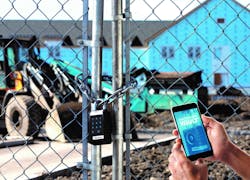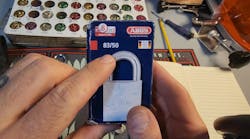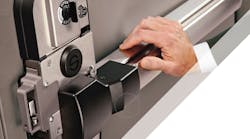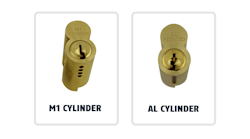Padlocks are one of the oldest mechanical security solutions, dating back thousands of years. As the push to increasingly sexy high-tech and touchless electronic security solutions accelerates, it might seem that the padlock’s day has come and gone as anything more than a simple solution aimed directly at end users.
However, the latest padlocks have some of those high-tech features built into their bodies, and locksmiths would do well to remember padlocks as a potential security solution well beyond a mere sale at the lockshop.
“We still carry a very large selection of padlocks,” says Larry Schwalb, who owns Houdini Lock & Safe, a three-location locksmithing business in and around Philadelphia. He notes that he carries American and Master Lock models but acknowledges that the sale of standard padlocks to customers has gone to big-box stores and Amazon.
It’s the high-end professional or “specialty” padlocks, however, “where people come to see us,” he says. For those applications, he carries products “more in the locksmith brands,” such as ABUS and Medeco.
It’s a good reminder that, as with door hardware, different padlocks are available for different solutions, and it’s important to get that word out because of potential confusion by the public. Whereas very few people have purchased, say, an automatic door operator, just about everyone has bought a padlock at some point.
“People often do a self-assessment” of padlocks, Schwalb says. “It looks strong; it feels strong; [so] it must be strong. A lot of times, they’re just trying to save a dollar. It’s crazy. They want to spend $4 to secure $4,000.”
Schwalb uses the example of a restaurant that might have a storage container behind the building. These containers can be burglary-resistant, but a conventional padlock on such a container could be “the hole in the fence.” He notes that Original Lishi, for example, now makes picks that allow anyone to pick standard American and Master Lock cylinders.
High Value = High Security
The primary application for high-security padlocks is critical infrastructure — electric utilities, telecommunications, water, traffic and the like — particularly at remote, outdoor locations that don’t allow for constant in-person supervision or monitoring. But other possible applications include apartment buildings or even schools that store valuable items outside where access is meant only for maintenance workers or high-level officials, says Rose Jones, associate product manager at SALTO.
Schwalb agrees that high-security padlocks can be applied to a broad range of applications. He says his company once used padlocks on a supermarket that had walk-in storage areas that opened outside. The use of high-security padlocks allows vendors to stock their goods at times outside the store’s hours, say, 4:30 a.m., and management to track the deliveries if the lock provides audit-trail data.
So, high-security padlocks are considered “whenever we’re working with a masterkey solution where they’re looking for accountability as well as easy administration of a method of locking up a number of rooms or containers,” Schwalb says.
Of course, that begs the question as to what’s considered to be high security when it comes to padlocks. Aside from the obvious consideration that it shouldn’t be something you can buy at a local grocery store, it depends. Different manufacturers use different methods and define high security a bit differently.
In general, however, some common features define high-security padlocks. These include solid bodies consisting of a boron alloy or hardened steel (even solid stainless steel) made to stand up to the elements and physical attack. They also include shackles that can be more than one-half of an inch in diameter.
“We’ve really extended the security of the shackle into the 4-foot or longer bolt cutters,” says Barron Robertson, director of product management for Master Lock. “There, you’re going to be looking at somebody who has thrown surreptitious violation out the window, and it’s a full-on attack.”
To reduce the threat of that, Master Lock and others provide shackle guards as an option to prevent someone from being able to get a bolt cutter on the shackle. However, manufacturers acknowledge that if someone wants to get into an area protected only by a padlock badly enough, given enough time, particularly in a remote area, they can. Because of that, other solutions, such as surveillance video and motion lighting, might be considered as a security complement for certain applications.
Another common feature for mechanical padlocks is the implementation of high-security cylinders that are resistant to drilling or picking. Several manufacturers provide multiple cylinder options for their padlocks, including small-format interchangeable cores.
They also provide multiple keying options, including the use of patented keyways that make it illegal to make key copies. This is an important feature when it comes to marketing high-security padlocks, says Morgan Lewis, an outside sales representative for ABUS.
“It gives the public, I guess you could say, ‘warm fuzzies’ that they know that somebody can’t just go down to the local Home Depot and make a key,” he says.
Powering Up
Key control is a big consideration when it comes to applying high-security padlocks to critical infrastructure, because, of course, no one wants a stray key to, say, a wind generator or a cellphone tower floating around out in the public.
Consequently, the demand for key control has led not only to an increase in electrified options among high-security padlocks but also in the sophistication of what the electronics can do. Manufacturers handle electrification of padlocks generally in one of two ways: Some put the electronics in the key; others have it in the padlock.
Of course, manufacturers that put the electronics in the padlock have to build lock bodies big enough to hold electronic components and batteries, resulting in padlocks that don’t fit comfortably in a hand. They also have to provide extra protection from moisture and potential vandalism through reinforced bodies and rubber gaskets and covers.
What electrification at the padlock (and by electrified, we mean battery power, of course) really brings to the table is accountability through access control. This accountability is accomplished by limiting access to only certain people at certain times and by keeping track of who accessed what padlock when.
“Key-scheduling capabilities are big,” says Jorie Nove, a sales and marketing representative of CyberLock. “I could say I want you to have access to these five padlocks Monday through Friday, 8 to 5, and outside of that schedule, you’re going to be denied access.” Such scheduling can be handled through electromechanical keys or mobile credentials that unlock the padlock in question.
When the padlock is connected to software, end users can perform audit trails of who tried to access the lock. If the connection occurs through Bluetooth or Wi-Fi to a mobile device, “it’s a near real-time audit trail,” Nove says.
The audit-trail capability is a particularly valuable component of electronic padlocks, Schwalb agrees, because it provides something that video surveillance can’t, particularly in this age of increased mask-wearing.
“It gives you a tool to precisely see who stuck their nose in and touched something last and possibly use that information to either make things more streamlined or more secure,” he says.
Although electronic padlocks that provide access control certainly could be used for a stand-alone application, they increasingly are part of a broader solution. Depending on the manufacturer, these padlocks could be linked to other security products, such as door locks, door controllers and card readers, on one access control system.
As a result, the relatively small form factor of a padlock makes it a good way to introduce access control to facilities that don’t have it, says Luis Saldana, SALTO’s technical director of North & Latin America.
“This is maybe another tool that you have to open a project that eventually could grow from one or two padlocks to 10 access points,” he says. “And now you have a happy customer, because you solved not only the issue of access to a facility, but also key management and remote control.”
Below is a roundup of a few high-security padlocks.
ABUS Granit 37 Series
ABUS Granit 37 padlocks are mechanical models that have high security clearly in mind. ABUS says the padlocks have a tensile strength of more than 6 tons.
The body and shackle of Granit 37 padlocks are made from a hardened steel alloy, and the newest model, 37ST/55, is solid stainless steel for extreme corrosion resistance. Shackles are as thick as thirty-five-sixty-fourths of an inch, and two sizes of padlock include shackle guards that make for a shackle height of as little as five-eighths of an inch. (Shackle lengths go up to 3 inches on other models.)
What makes the Granit 37 Series particularly stand out is its Plus locking system, Lewis says. The system consists of a seven-disk cylinder that’s effective against manipulation.
“And you can only get those keys from ABUS,” he says. Each model comes with two keys, one of which includes an LED for use in darkness. “It’s a very secure padlock.”
All of the padlocks except for the solid stainless steel model can be keyed alike, keyed different or made part of a masterkey system and can be rekeyed to match an existing key. (The 37ST/55 is keyed different only.)
ABUS also sells hasps that match the construction of the Granit 37 padlocks.
More info: www.abus.com/us
CyberLock Anchor Las Padlock
The newest padlock to the CyberLock ecosystem is made by Anchor Las, comes in two shackle lengths and has a chrome-plated hardened steel body and a sealed design that makes it drill- and pick-resistant.
Being part of the CyberLock system means that the padlock uses the electronic CyberKey, which energizes the cylinder and allows the lock to open — as long as that key has access privileges for that day and time. It also provides an audit trail of the padlock.
“It’s access control without the hard wiring, which is ideal for remote locations,” Nove says.
She says the Anchor Las padlock cylinder options include CyberLock’s new Gen 2 cylinder, which includes a faster processor and expanded memory. The result is Gen 2 padlocks can provide an audit trail of up to the most recent 6,500 events, compared with 1,100 in the older generation.
The Gen 2 cylinder features AES 256 encryption between the padlock and the key, which Nove says is an advance of the older cylinder’s proprietary encryption. The lock also is key-retaining, so it won’t release the key until the padlock is relocked.
More info: cyberlock.com
Master Lock ProSeries Bluetooth
The new three-model ProSeries Bluetooth line is an extension of Master Lock’s Vault Enterprise system, which includes padlocks and a door controller that can be controlled through the Vault mobile app. However, the padlock itself was as much a focus of the design, Robertson says.
“It was designed from the ground up to meet commercial application needs,” he says. “It’s really built around the security of the traditional Master Lock ProSeries mechanical locks from a physical-security standpoint.”
That means a body that provides enhanced resistance to rain, snow and temperature extremes and a boron shackle that’s eleven-thirty-seconds of an inch in diameter. One model includes a shackle guard. The result is a padlock that’s nearly 5-1/2 inches long at minimum and weighs up to 2 pounds.
The padlock’s electronics are the main reason for the sheer size of the padlock, Robertson says. As the name would suggest, the padlocks allow for mobile credentials and mobile monitoring of audit-trail data through a Bluetooth connection.
Interestingly, Robertson notes a more retro feature on the new series — the 10-digit keypad. This new addition provides end users with more access options.
“There are a lot of different use cases, and frequently there’s a need for flexible modes of entry,” he explains. “What we’ve been able to provide are both Bluetooth credentials” and access through the keypad.
The keypad allows for timed single-use access, Robertson says. For example, a contractor could be given a temporary code that automatically stops after a set period.
More info: www.masterlock.com
SALTO Neoxx
At the heart of SALTO’s new Neoxx padlock is the company’s NEO smart cylinder. The NEO is the core of the company’s access control solution, which means that in addition to bringing mobile credentialing and monitoring to the padlock, the padlock also can be tied into a complete SALTO access control system.
This had been true of SALTO padlocks that used the older GEO cylinder, but Saldana notes that the change in cylinders necessitated a complete rebuild of the company’s padlock. The result is the Neoxx, which is nearly 7 inches long, including the 2-inch shackle, and weighs more than 2 pounds.
“The old padlock was not as strong as this one by far,” Saldana says. The company not only completely enclosed the NEO cylinder and isolated more of the electronics from the elements, but also provided a rubber cover that provides additional protection from weather and physical attack. “The GEO had some limitations when it was exposed to the elements. [The Neoxx] is supposed to perform in any kind of environment.”
The padlock also is meant to perform for multiple credentials. These include mobile through Bluetooth or near field communications (Google Android phones) and MIFARE DESFire or HID iCLASS Seos prox fobs and cards. Four LR1 batteries provide up to 130,000 cycles.
As far as tying it to a SALTO platform, end users pretty much have their choice: BLUEnet, KS, Space and SVN compatibility are enabled. Different systems provide different features, including remote lockdown or opening.
“This is not just an electronic padlock; it’s a complete locking platform,” Saldana says.
More info: www.saltosystems.com/en-us/





